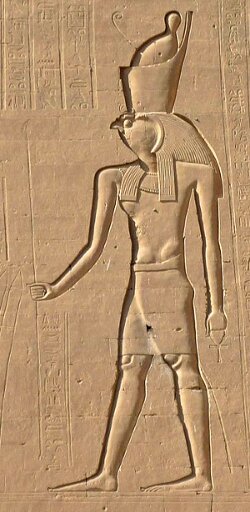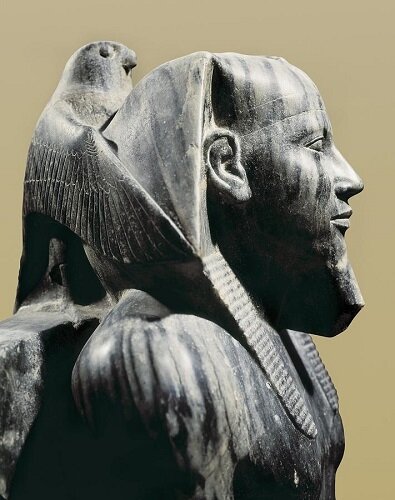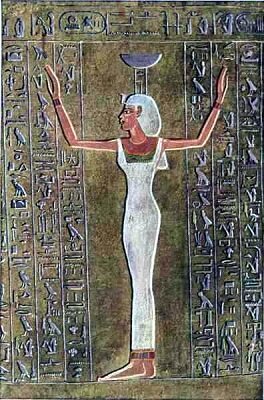The Sunday Section: Ancient Egypt - The Osiris Myth
Perhaps the most popular and elaborate story in Ancient Egyptian mythology is that of the murder of Osiris.
Osiris (wikimedia commons)
One reason for its popularity is that the characters and their emotions mirror that of real people. According to the Egyptologist, J Gwyn Griffiths, the myth conveys a “ strong sense of family loyalty and devotion”. Another reason is the myth’s implication of a pleasant afterlife for the deceased. Also, the myth’s complex symbolism embraces key Egyptian concepts of kingship and succession, ma’at and chaos, and death and the afterlife. Interestingly, the elements that made up the worship of Isis, Osiris, Nephthys and Set were derived from this myth.
There is no one standard version of the Osiris myth as it was used in many ways, with different conflicting versions. Of all the interpretations, this is the one I’m most familiar with. Curiously, despite the numerous references to the murder of Osiris, the act itself is never clearly described. This is because the Egyptians believed that written words had the power to affect reality. The story is, more or less, in two parts, with Osiris’ death and resurrection in the first, and his son, Horus, battling Set in the second.
Osiris, the first son of Geb and Nut, took over ruling Egypt when Geb retired to the heavens. After marrying his sister, Isis, Osiris began his wise reign of the Egyptians. Turning them from cannibalism, he introduced them to farming instead; and also framed a legal code for them. Under his wise rule, the country flourished. Eager to share his knowledge and wisdom to the world, he entrusted the rule of the land to his queen, and left to travel the world. Under Isis’ equally wise rule, the land continued to thrive.
Osiris and Isis - Abydos
However, all was not well in the land. Osiris’ brother, Set, nursed a murderous hatred for his brother, envying Osiris’ power. He used his cunning to gain allies, whom he also bribed to ensure their loyalty, and they set about devising a plan to kill Osiris when he returned. Set found out Osiris’ exact measurements, and had a box made that would fit only him.
When Osiris returned, Set held a banquet in his brother’s honour. After much food had been eaten, and much beer drunk, Set ordered the beautiful cedar box, inlaid with ebony and ivory, gold and silver, to be brought into the hall, saying that he would make a gift of it to the person who fitted it exactly. Everyone present took their turn but it fit none of them. Until Osiris stepped in and lay down, smiling in surprise at the exact fit. In the next instant, Set and his fellow conspirators slammed the lid shut, and sealed it with lead. The box was then thrown into the Nile, and Set announced that he was now king of Egypt.
Set, depicted on the left
Consumed with grief, Isis travelled along the Nile, searching for the box that contained her husband, so she could bury him properly. Her search eventually led her to Phoenicia where she met the queen. Keeping her identity secret, she was taken on as a nurse to the queen’s infant son. Growing fond of the child, Isis decided to bestow immortality on him. Waiting until night when all were asleep, she performed a ritual that involved holding the infant over a fire to burn away his mortality. But the queen entered the room before the ritual was complete. Seeing her son being held over a fire, she screamed and snatched her son away, undoing Isis’ spell. She demanded an explanation, and Isis revealed her true identity. Awed, the queen begged forgiveness, and asked why Isis was travelling as a commoner. Isis spoke of her quest to recover her husband’s body, and she described the box that held Osiris. Shocked, the queen realised that the box Isis described was in her house. She explained that a box had become lodged in a tamarisk bush, which had swiftly grown into a mighty tree; her husband had had it cut down to be made into a pillar in their hall. On being told, the king ordered the tree to be cut down, and the box was revealed. Tearing it open, Isis wept over the body of her husband.
Carrying the box back to Egypt, Isis, and her sister, Nephthys, set about reviving Osiris. They were aided by Thoth with his magical and healing powers, and Anubis, the god of embalming and funerary rites.
Once Osiris was made whole, Isis, hovering over him in the form of a bird, conceived their son, Horus.
Isis in bird form hovering over Osiris, with Isis in human form and Horus, as yet unborn, on either side; at Abydos (image by Olaf Tausch)
Osiris rising between Isis and Nephthys
But, once claimed by death, not even a god can remain in the land of the living. Osiris descended to the Netherworld, to Duat, to stand in judgment over the souls of the dead.
To hide from Set and his followers, Isis hid in the swamps of the Nile delta; it was here that she gave birth to Horus, and raised him, with the help of Nephthys, who was Horus’ nursemaid and watchful guardian.
Osiris, Isis and infant Horus (image by Andrew Bossi)
Learning of Horus’ existence, knowing that the child was the rightful heir, Set sent demons and snakes to kill the child, but, each time, Isis and Nephthys successfully protected him, and he grew into adulthood, strong and ready to face his uncle.
Horus
Horus challenged Set for the throne, and they fought for many days. Although violent, the contest has also been described as a legal judgment before the Ennead, a group of 9 deities in Egyptian mythology, to decide who should inherit the throne. (Confusingly, the Ennead, who were worshipped at Heliopolis, consisted, not only, of Atum, his children, Shu and Tefnut, their children, Geb and Nut, but also their children, Osiris, Isis, Set and Nephthys.)
In the course of the conflict, mutilations were inflicted by both parties, with Set tearing out one of Horus’ eyes, and Horus injuring Set’s testicles. The damage that Set endured signified a loss of virility and strength. But the loss of the Eye of Horus was more important. As a sky deity, Horus’ right eye was said to be the sun, and his left eye, the moon. The loss of the Eye of Horus was equated with the darkening of the moon, and eclipses. In Egyptian religion, the return of the Eye of Horus represented the return of the moon to its full brightness, the kingship being bestowed on Horus, and other aspects of ma’at.
Horus, helped by Isis, spearing Set in the guise of a hippopotamus, Edfu temple
The resolution of the conflict is, again, varied. One view has Horus and Set dividing the realm between them, with Horus receiving the fertile lands around the Nile, and Set having the barren desert. Another view is that Horus triumphed, and Set was totally defeated, and exiled from Egypt. Horus took the throne, and Egypt, finally, had its rightful king. The land flourished again, and Horus sired 4 sons from whom the line of Pharaohs was descended.
Horus wearing the double crown of Egypt (image by ‘cow of gold’ was on Wikispaces)
The Eye of Horus, flanked by the Four Sons of Horus
Horus protecting Khafre
A couple of interesting notes – one of the reasons given for Set’s hatred of his brother was that he discovered his wife, Nephthys, had seduced Osiris, and borne their son, Anubis. I always found that confusing as it was Nephthys who mourned with Isis over Osiris, and it was she who was Horus’ ‘nursing-mother’ and guardian.
Nephthys
But recent Egyptological research now holds that there is little evidence linking Nephthys and Set. Jessica Levai, in her paper, ‘Nephthys and Seth: Anatomy of a Mythical Marriage’, argues that the evidence suggests that:
“… while Nephthys’ marriage to Set was a part of Egyptian mythology, it was not a part of the myth of the murder and resurrection of Osiris. She was not paired with Set the villain, but with Set’s other aspect, the benevolent figure who was the killer of Apophis. This was the aspect of Set worshipped in the western oases during the Roman period, where he is depicted with Nephthys as co-ruler.”
Set with Nephthys (Image by Joan Lansberry)
Also, the part of the story that tells of Isis attempting to bestow immortality on the Phoenician queen’s son is very similar to the Greek mythological story of Demeter searching for her daughter, Persephone, who had been kidnapped by Hades, Lord of the Underworld; as a gift to Celeus' for his hospitality, Demeter had sought to make his son, Demophon, immortal.
So, dear reader, that concludes the Sunday Section of Ancient Egypt. I hope you find it as interesting as I did, researching it.












